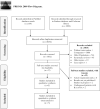The effects of resistance training with blood flow restriction on muscle strength, muscle hypertrophy and functionality in patients with osteoarthritis and rheumatoid arthritis: A systematic review with meta-analysis
- PMID: 34758045
- PMCID: PMC8580240
- DOI: 10.1371/journal.pone.0259574
The effects of resistance training with blood flow restriction on muscle strength, muscle hypertrophy and functionality in patients with osteoarthritis and rheumatoid arthritis: A systematic review with meta-analysis
Abstract
Introduction: Rheumatoid arthritis(RA) and osteoarthritis(OA) patients showed systemic manifestations that may lead to a reduction in muscle strength, muscle mass and, consequently, to a reduction in functionality. On the other hand, moderate intensity resistance training(MIRT) and high intensity resistance training(HIRT) are able to improve muscle strength and muscle mass in RA and OA without affecting the disease course. However, due to the articular manifestations caused by these diseases, these patients may present intolerance to MIRT or HIRT. Thus, the low intensity resistance training combined with blood flow restriction(LIRTBFR) may be a new training strategy for these populations.
Objective: To perform a systematic review with meta-analysis to verify the effects of LIRTBFR on muscle strength, muscle mass and functionality in RA and OA patients.
Materials and methods: A systematic review with meta-analysis of randomized clinical trials(RCTs), published in English, between 1957-2021, was conducted using MEDLINE(PubMed), Embase and Cochrane Library. The methodological quality was assessed using Physiotherapy Evidence Database scale. The risk of bias was assessed using RoB2.0. Mean difference(MD) or standardized mean difference(SMD) and 95% confidence intervals(CI) were pooled using a random-effects model. A P<0.05 was considered statistically significant.
Results: Five RCTs were included. We found no significant differences in the effects between LIRTBFR, MIRT and HIRT on muscle strength, which was assessed by tests of quadriceps strength(SMD = -0.01[-0.57, 0.54], P = 0.96; I² = 58%) and functionality measured by tests with patterns similar to walking(SMD = -0.04[-0.39, 0.31], P = 0.82; I² = 0%). Compared to HIRT, muscle mass gain after LIRTBFR was reported to be similar. When comparing LIRTBFR with low intensity resistance training without blood flow restriction(LIRT), the effect LIRTBFR was reported to be higher on muscle strength, which was evaluated by the knee extension test.
Conclusion: LIRTBFR appears to be a promising strategy for gains in muscle strength, muscle mass and functionality in a predominant sample of RA and OA women.
Conflict of interest statement
The authors have declared that no competing interests exist.
Figures





Similar articles
-
Effect of blood flow restriction with low-intensity resistance training in patients with osteoarthritis and rheumatoid arthritis: a systematic review and meta-analysis based on randomized controlled trials.Phys Act Nutr. 2024 Mar;28(1):7-19. doi: 10.20463/pan.2024.0002. Epub 2024 Mar 31. Phys Act Nutr. 2024. PMID: 38719461 Free PMC article.
-
Effects of Blood Flow Restriction Training on Strength and Functionality in People With Knee Arthropathies: A Systematic Review and Dose-Response Meta-Analysis of Randomized Controlled Trials.Transl Sports Med. 2025 Apr 10;2025:3663009. doi: 10.1155/tsm2/3663009. eCollection 2025. Transl Sports Med. 2025. PMID: 40256207 Free PMC article. Review.
-
Effects of Blood Flow Restriction Therapy for Muscular Strength, Hypertrophy, and Endurance in Healthy and Special Populations: A Systematic Review and Meta-Analysis.Clin J Sport Med. 2022 Sep 1;32(5):531-545. doi: 10.1097/JSM.0000000000000991. Epub 2021 Nov 29. Clin J Sport Med. 2022. PMID: 36083329
-
The Effect of Low Intensity Resistance Training with Blood Flow Restriction on Fall Resistance in Middle-Aged and Older Adults: A Meta-Analysis.Int J Environ Res Public Health. 2023 Mar 7;20(6):4723. doi: 10.3390/ijerph20064723. Int J Environ Res Public Health. 2023. PMID: 36981632 Free PMC article. Review.
-
Effects of Muscle Strength Training on Muscle Mass Gain and Hypertrophy in Older Adults With Osteoarthritis: A Systematic Review and Meta-Analysis.Arthritis Care Res (Hoboken). 2020 Dec;72(12):1703-1718. doi: 10.1002/acr.24097. Arthritis Care Res (Hoboken). 2020. PMID: 31628720
Cited by
-
The impact of blood flow restriction training combined with low-load resistance training on the risk of falls in patients with knee osteoarthritis in China: a single-centre, two-arm, single-blind, parallel randomised controlled trial protocol.BMJ Open. 2025 Mar 5;15(3):e092689. doi: 10.1136/bmjopen-2024-092689. BMJ Open. 2025. PMID: 40044206 Free PMC article.
-
Effect of blood flow restriction with low-intensity resistance training in patients with osteoarthritis and rheumatoid arthritis: a systematic review and meta-analysis based on randomized controlled trials.Phys Act Nutr. 2024 Mar;28(1):7-19. doi: 10.20463/pan.2024.0002. Epub 2024 Mar 31. Phys Act Nutr. 2024. PMID: 38719461 Free PMC article.
-
Effects of Blood Flow Restriction Training on Strength and Functionality in People With Knee Arthropathies: A Systematic Review and Dose-Response Meta-Analysis of Randomized Controlled Trials.Transl Sports Med. 2025 Apr 10;2025:3663009. doi: 10.1155/tsm2/3663009. eCollection 2025. Transl Sports Med. 2025. PMID: 40256207 Free PMC article. Review.
-
Effects of interventions with resistance exercises on muscle strength, physical disability, and quality of life in systemic sclerosis patients: a systematic review with meta-analysis.Adv Rheumatol. 2025 Jul 28;65(1):34. doi: 10.1186/s42358-025-00468-1. Adv Rheumatol. 2025. PMID: 40721843
-
Practical Blood Flow Restriction Training: New Methodological Directions for Practice and Research.Sports Med Open. 2022 Jun 28;8(1):87. doi: 10.1186/s40798-022-00475-2. Sports Med Open. 2022. PMID: 35763185 Free PMC article.
References
-
- Baker JF, Mostoufi-Moab S, Long J, Zemel B, Ibrahim S, Taratuta E, et al.. Intramuscular Fat Accumulation and Associations With Body Composition, Strength, and Physical Functioning in Patients With Rheumatoid Arthritis. Arthritis Care Res. 2018;70:1727–34. doi: 10.1002/acr.23550 - DOI - PMC - PubMed
Publication types
MeSH terms
LinkOut - more resources
Full Text Sources
Medical

